Thibs Time, Part 2
Was it the scheme or the players in Minnesota that led to his downfall? It might have been a little bit of both.
As we did on Monday, without thinking too much, tell me what you see:
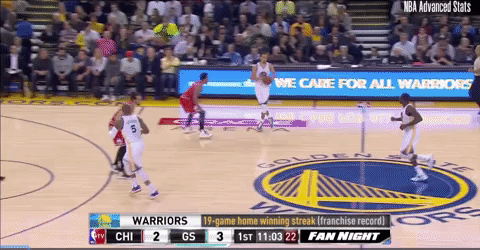
At fist glance, it looks…well, it looks exactly like the clip I started off the last newsletter with.
The shooter plays the same position, picks the same shot location, eschews a pick the same way, sees the same intentional drop coverage from the big, and fires away with the same result. It’s basically the same exact play. Hell, the games took place a little more than a month apart during the 2014-15 season.
Except they couldn’t be more different.
For one, the shooter here (Klay Thompson) was hitting nearly 46 percent of his threes on seven attempts per game, compared to Anderson (27%, 1.7 attempts) in Monday’s clip.
Second, whereas Taj Gibson in the original clip had no qualms about laying off Mason Plumlee - he of zero career 3-pointers at the time - Joakim Noah needs to at least acknowledge Draymond Green’s existence here. After all, in the previous game the Bulls and Warriors played about a month and a half earlier, Green went 7-for-13 from downtown. Chicago repeatedly letting him shoot it - and him continually making them pay - was arguably the biggest difference in that game.
And then of course there is the matter of the other players on the court. Steph Curry, for one, exists in a perpetual state of flames shooting out of his butt. Harrison Barnes came into the game shooting a more-than-respectable 42.7 percent from deep. Even Mo Speights occasionally dabbled from the outside, albeit of the long two variety.
All told, whereas Anderson’s shot was one Chicago was happy to give up, no NBA team could hope to win, even in 2014-15, while giving up looks like the one the Bulls allowed Klay to have here, right?
Except Chicago did win, ending the Warriors’ 19-game home winning streak and becoming the second and last visiting team to emerge from Oracle with a victory that season.
What gives?
Welcome to the NBA in 2020. Thanks to the onslaught the Warriors’ wrought five seasons ago, there has been a series of reactions, and then reactions to those reactions, over the last half decade. In short:
Everyone started shooting more and more threes (an increase of 51.3 percent in the last five seasons, as opposed to an increase of just 23.7 percent in the seven seasons before that).
Teams started trying to take away those threes almost as quickly as opponents started putting them up.
Good teams realized offenses had gotten too advanced for defenses to take away both threes and shots at the rim, so the best defenses started becoming adept at taking away only certain threes while showing more indifference to the worst 3-point shooters, all while making sure the restricted area remained off limits.
This last part is really, really hard.
Knicks fans know the sensation well: watching an opposing offense and tracking the ball as it swings from player to player, only to end up in the hands of a wide open sharpshooter who you just know is going to drain the basket before it even reaches his hands.
New York, unsurprisingly, finished 25th in frequency of opponents’ 3-pointers and 28th in opposing field goal percentage on such shots. When the NBA shut down in March, they were the only team in the bottom six of both categories according to Cleaning the Glass, and while those numbers improved slightly under Mike Miller, neither was appreciably better. In related news, the Knicks’ defense stunk.
But the culprit isn’t where you think - well, not completely, at least.
At no point this season did the Knicks ever do what Thibs’ Bulls did so well and successfully take away the rim. While there was a decrease in frequency of restricted area shots allowed after Miller simplified the defensive scheme - their ranking jumped from 20th to 10th - it wasn’t enough to make a significant dent, and New York only rose from 22nd to 20th in overall defense after they switched coaches.
Chicago gives up a great look in the clip we started with above, but they were still a well-oiled machine, and the math worked out in their favor more often than not. Sure enough, aside from Klay’s triple, Golden State hit just 25 percent of their 3-point attempts that evening.
Did the Bulls get lucky? Sure, a bit. But when the choice is giving up threes or shots up close, the numbers speak for themselves:
This season, according to Cleaning the Glass, the eight best teams in terms of frequency of threes allowed finished 6th, 10th, 18th, 20th, 21st, 23rd, 28th and 30th in overall defense.
The eight teams that were best at taking away the rim, however? 1st, 2nd, 4th, 5th, 8th, 10th, 11th and 12th.
This math was as true five years ago as it is now. As I wrote yesterday, the Bulls defended the rim as well as anyone right up till Thibs departure (10th in opp. frequency, 1st in opp. FG%), and their scheme left most opponents happy with whatever they could get. As a result, teams shot more long two’s - the worst shot in basketball - against the Bulls in 2014-15 than against any other team.
Fast forward to where we left off yesterday’s newsletter, and the question of whether Thibs’ failure in Minnesota had to do with the scheme or the players.
Let’s start by taking a gender at this play from the 2017-18 season, the only year the Wolves employed Jimmy Butler but he wasn’t yet a massive distraction who openly demanded a trade and yelled profanities at his teammates before the season even tipped off:
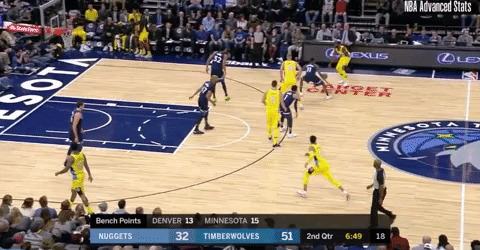
This is the Wolves trying to ICE the pick and roll, although I use the term “try” loosely. It’s more like Jamal Crawford pulling out his finest red cape and escorting Will Barton to the hole. Is he defending, or hailing a cab? Who can be sure, really? Not wanting to be outdone, KAT also makes an appearance to make sure Barton arrives safely and unscathed with all of the luggage intact.
It’s an “I’m where you told me to be can I get my cookie now please and thank you” level of effort.
Also notice Taj on this play. He’s guarding Nikola Jokic, who’s hanging out behind the 3-point line, and is enough of a threat to make Gibson think twice (37.4 percent on 3.4 attempts coming into this game). Then there’s Wilson Chandler in the corner. He was only at 32 percent coming into this one, but Nemanja Bjelica clearly feels queasy about leaving him alone once he’s seen Barton has a passing lane.
Yet either of those options would have been preferable to allowing Plumlee get a look that he makes 100 times out of 100. The problem is that defense is built on trust, and both Taj and Bjelica weren’t wrong to trust that their teammates would do their jobs.
But trust is a funny thing, and when it breaks down, shit can start to run downhill in a hurry. Here, for example, is Denver’s next basket:
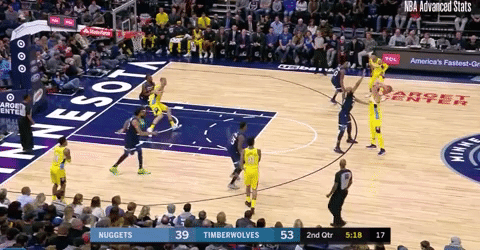
No one wanted to leave their man, even though in this instance, it was clearly warranted.
KAT and Wiggins are the last lines of defense here. Wiggins is guarding our non-shooting friend from yesterday’s top clip, Mason Plumlee. That he didn’t make an effort to get over is inexcusable, although Towns’ error isn’t much better. Sure, Gary Harris is in the corner, but Towns is still the rim protecter here, or the closest thing the Wolves have to one. It was on him to get in the way.
So is this the scheme, or the players? Let’s check out the next Wolves bucket:

Here, Jeff Teague and Andrew Wiggins have to know that their assignments switch in the middle of the possession. The only problem is that Teague does and Wiggins doesn’t. Both players’ attention goes to Chandler cutting to the hoop - again, protect the rim at all costs, right? - but the result is the most wide open look Murray had all game.
Here’s the next basket after that:
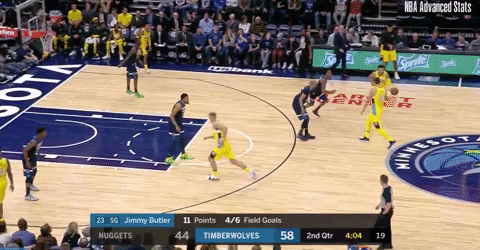
Finally, everything goes right (well, almost everything - Jeff Teague being able to guard another living soul would be a nice touch) until Andrew Wiggins fails to box out Plumlee.
Which brings us to, perhaps, the most astounding fact about the 2017-18 Wolves: despite being the only team in the league to play a pairing of traditional big men over 2000 minutes (KAT & Taj) and having two other bigs as rotation regulars (Bjelica and Dieng), Minnesota finished 24th in the NBA in percentage of offensive rebounds given up. How in the hell can that possibly be?
A clue comes from the 2014-15 Bulls. Despite having the trio of Noah, Gasol and Gibson, Chicago only ranked 17th in keeping opponents off the boards. It was easily the lowest ranking of Thibodeau’s tenure in Chicago (and a far cry from his first year coaching the Bulls, when they finished 3rd) and part of the explanation for their fall to 11th in overall defense.
This is a byproduct of selling out to protect the rim - or trying to, at least. A big lineup don’t mean anything if people aren’t in a position to body up their man, which can happen when slow and/or unaware defenders are left to over-rotate.
Or, you know…this can happen:
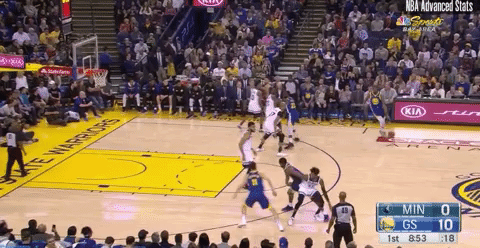
To see this and know that the 2017-18 Wolves starting five, despite including the three stooges (Towns, Wiggins and Teague), had a league average defense is downright miraculous. But when you throw in 2000+ minutes of Jamal Crawford, Shabazz Muhammad and Aaron Brooks - all in the first or second percentile league-wide in on/off differential for defensive rating that season - the dam breaks, and you get a 23rd ranked defense.
Compare that to the 8th ranked defense Minnesota sported in Thibs’ final 27 games as coach during the 2018-19 season, after they swapped a mercurial Butler for Robert Covington and Dario Saric. In addition to those two, Crawford was also gone, with Derrick Rose (who, while never a great defender, was intimately familiar with Thibs’ schemes) playing a much larger role, and rookie Josh Okogie doing his part as well.
More than anything - more than KAT or Wiggins’ individual inconsistency and occasional ineptitude, more than the fact that he stayed big when everyone else was going small, and certainly more than any fault in his scheme - Tom Thibodeau the coach failed in Minnesota because Tom Thibodeau the front office man did a shitty job assembling a team.
Thibs gave himself a team overstocked with porous defenders that Jimmy Butler and Taj Gibson couldn’t lift up by themselves, and then leaned into the worst of those by playing them far too much, perhaps foolishly thinking his principals would eventually win the day. Instead, it just made his principles look like relics.
Were the principals outdated though? Let’s take a look at another game from the 2017-18 season:
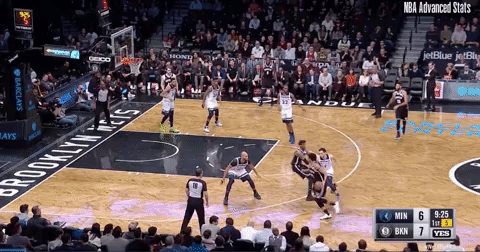
This is a quick play but it’s telling. The coverage here is designed make Dinwiddie give up the ball, and he does just that, to an open Allen Crabbe. Andrew Wiggins, as he is wont to do, is a step slow getting out, but he does enough to bother Crabbe, who misses.
You might notice that the starting lineup here isn’t the Wolves normal one from that season, with Tyus Jones replacing Jeff Teague to join KAT, Wiggy, Jimmy and Taj. Talk about what a difference one player can make:


In the minutes Jones replaced Teague that season to give the Wolves an actual, honest-to-goodness point of attack defender, Minnesota’s defense improved from league average to the best in basketball by a comfortable margin.
It’s the same logic displayed by the discrepancy in Minnesota’s defensive rating with Jimmy and Taj on the court (105.8) vs when they were off (113.4):
The evidence is pretty clear that in the modern game, Thibs’ scheme can work fine…if there’s no one on the court to screw it up. Let’s bring this thought home with one last play:
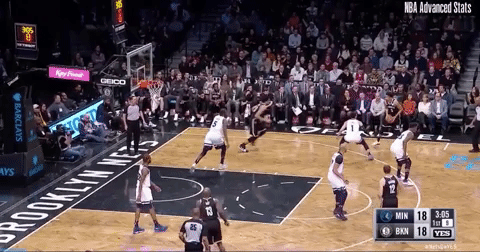
Like the first clip from this game, Wiggins is again late to react, except this time it’s more egregious, and Joe Harris knocks down the shot. He was the one weak spot on the court, and the Nets exploited it.
It was one of 14 Brooklyn triples on the evening on just 30 attempts. That’s about as unlucky as you’re going to get as a defense. The Wolves also gave up an ungodly conversion rate at the basket, as the Nets hit 69.2 percent of their shots at the rim. This, again, is not the norm.
In total, the Nets’ eFG% for this game was 61.1 percent compared to the Wolves 45.6, and yet they only lost the game by one, on a tough fadeaway game winner from Dinwiddie.
Why was it even this close despite all these terrible numbers? Simple: the Wolves forced 19 turnovers and only allowed 26 shots at the basket.
While such a turnover number isn’t the norm for a Thibs defense, it can happen when a team isn’t careful against a sound scheme:
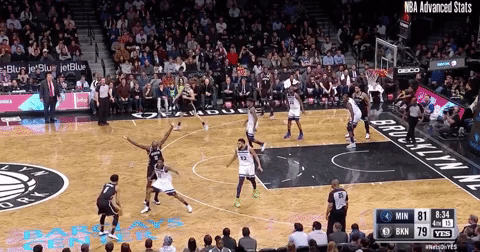
As many have noted, Thibs’ defense is susceptible to great passing and great shooting, and no, it doesn’t do well when there’s a weak link in the chain.
But with offenses what they are today, the same can be said of any defense. The Warriors allegedly reinvented NBA defense with their switching scheme, and were ranked 26th this season. The Rockets are the ultimate in new age, putting five like-sized wings on the court, and even they’re only league average since the Capela trade.
The fact is there is no foolproof scheme in today’s NBA aside from having more good, versatile defenders than your opponent. Sure, some can limit the bleeding more than others, but ultimately it comes down to talent. Thibs’ Wolves didn’t have enough of it, but his core philosophy - guard the rim at all costs - is as sound today as it ever was.
If Thibodeau knew how poorly his players would react to his scheme, would he have tried something simpler from the beginning? Maybe. Or maybe he feels like his undoing was ultimately in how many minutes he gave to guys who were never fit for the challenge.
Regardless of the answer, my guess is that he would never take another job unless he knows he has the horses to work with. Like everyone else, Thibs sees the direction the league is going, where the best defensive rosters - teams like the Bucks, Celtics, Clippers and Raptors - can each throw out a group of five intelligent, aware, rangy, malleable defenders that give offenses no soft spots to attack.
Those four teams, of course, give up a ton of threes but take away the rim despite not having any traditional rim protectors on the roster (with all due respect to Brook Lopez and his 2.4 blocks per game this season).
Hopefully, if the Knicks job does in fact go to Thibs, he (and the front office) realizes that bigger isn’t better in 2020 and beyond. While Taj and KAT always achieved a league-average defensive rating together, such a pairing no longer has the collective agility and range required to survive. Again: the Knicks were the biggest team in the league last year and protected the rim worse than anyone.
Thibs will already have some pieces - Mitchell Robinson and Frank Ntilikina, to name two - but his success here will likely be determined elsewhere. If he gets the job, can he turn RJ Barrett - who had the worst on/off defensive stats on the team last year - into Jimmy Butler-light, or is he destined to be the next Andrew Wiggins? What would he do with Julius Randle, who shows flashes of on-ball competence but struggles to consistently stay engaged? How quickly would be be able to get the team’s lottery pick up to speed?
If Thibs Time is indeed in the offing, he’ll have a chance to prove once and for all that he’s every bit the defensive genius the entire league considered him to be for nearly a decade.
He just needs the right pieces to make his case.
That’s it! See everyone when there’s finally some coaching news! #BlackLivesMatter


